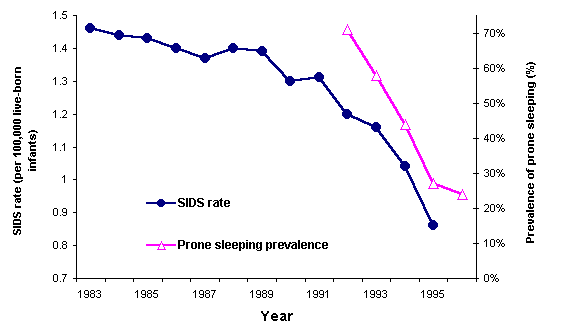|
Sudden Infant Death Syndrome (SIDS)
 | October is SIDS Awareness Month |
Definition: (SIDS = Crib Death)
The sudden and unexpected death of an apparently healthy infant, which remains
unexplained after a complete post-mortem investigation which includes an autopsy and an
examination of the circumstances of the death.
Notes:
 | The #1 cause of death in Canada for infants between 1 week and 1 year of age |
 | Claims 1/1000 live-born babies |
 | Essentially a Diagnosis of Exclusion / Pathological |
SIDS – Demographics
Statistics Canada (1995)
 | Total SIDS deaths is down to 252 from 269 (0.67 deaths/1000 live births)
|
 | Canadian Public Awareness campaign initiated in 1993.
It is interesting to note that the SIDS rate has not decreased significantly in the
last 3 years following the introduction of the campaign.
|
Rate of SIDS in
Canada per 1000 Live Births: 1985-1995
|
|
1995 |
1994 |
1993 |
1992 |
1991 |
1990 |
1989 |
1988 |
1987 |
1986 |
1985 |
|
| CDA |
0.67 |
0.70 |
0.68 |
0.82 |
0.88 |
0.82 |
0.99 |
1.04 |
1.06 |
1.02 |
0.88 |
Baby Profile:
 | Mothers who are not married, |
 | Mothers who are younger, |
 | Mothers with more than one infant, |
 | Mothers who smoke, |
 | Mothers who didn’t graduate from high school, |
 | Mothers who had inadequate prenatal care, |
 | Mothers who didn’t breastfeed their infants and |
 | Mothers who used heroin, cocaine or methadone during pregnancy. |
Other facts about SIDS:
 | SIDS occurs more during the winter and can be associated with a minor illness, |
 | Male infants are more likely to develop SIDS. Sixty percent of SIDS deaths are with male
infants, |
 | SIDS is more common on the west coast than on the east coast, |
 | Native American infants are at higher risk than African-Americans who are greater risk
than Caucasians, |
 | SIDS is more common in low birth weight infants, those weighing 3 ½ pounds or less at
birth |
Sids and the Prone Sleeping Position
 US Statistics US Statistics
 | In the US, 5000-6000 infants die annually between 2 mo – 1 year |
 | 1.2 deaths /1000 in 1992 |
 | 70 % à 24 % by 1996 placed infants in the prone position |
The Key Recommendations
0.5) Counselling may not be effective peri-partum/ prepartum and should be
reinforced at 3 months of life.
- Place normal, healthy infants on their back or side to sleep
– head molding/flattening
- Maintaining a smoke-free environment both before and after birth
- Do not allow the baby to become too hot
- bundling at night
- light blanket
- Breastfeeding if possible
– ? relationship?
Further Issues
Apnea Monitors
 | no evidence of mortality benefits and high rate of false alarms |
 | CHIME Trial
(Collaborative Home Infant Monitoring Evaluation) |
 | If used, until 6 months of age (90-95% of SIDS) unless further indicated |
 | The SIDS baby is unpredictable |
Remember that home monitors have not been proven to reduce the SIDS recurrence risk in
SIDS siblings regardless of the age at which it is stopped.
Parents of A Lost Child
 | Guilt and concerns over siblings |
 | Higher risk |
 | Risk Factors do not equal causation |
Resources Available
Non-profit Organizations
The Canadian Foundation for the Study of Infant Deaths
#308, 586 Eglinton Ave. East, Toronto, Ontario, Canada
M4P 1P2
Telephone: 800-END-SIDS; fax: 416-488-3864
E-mail: [email protected]
Internet address: http://www.sidscanada.org/sids.html
MotherRisk (Toronto Hospital for Sick Children)
www.motherrisk.org
Review Articles
Henderson-Smart, Ponsonby, Murphy. Reducing the risk of suden infant death syndrome:
A review of the scientific Literature. J. Paediatr. Child Health (1998) 34, 213-219
JAMA (1998) 280
- Effectively Delivering the Message on Infant Sleep Position,
373-4
- Factors Associated with the Transition to Nonprone Sleep Positions of Infants in the
United States
, 329
Pediatric Alert (1998) 23/15, "Back to Sleep" – How are we Doing?
|
